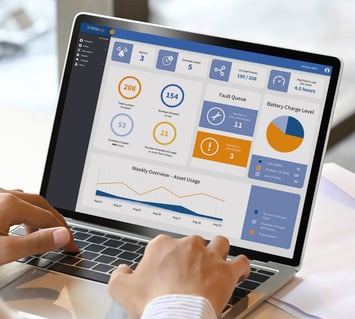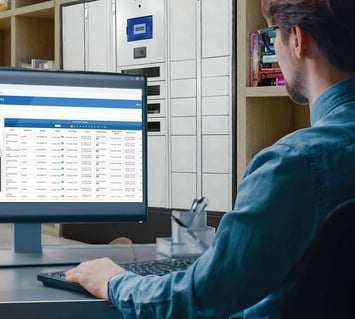By Jay Palter | March 8, 2023
The importance of Physical Access Control Systems (PACS) and Asset Control Systems (ACS) in their silos is well-understood. But little attention is paid to the benefits of integrating these systems.
- What is the Difference Between Physical Access Control Systems and Asset Control Systems?
- The Benefits of Integrating PACS and ACS
- PACS & ACS Security System Integration Process
- Essential Factors to Consider When Choosing an Integration System
- Integrated PACS and ACS Systems are Greater Than the Sum of their Parts
To properly understand the benefits of integrating physical access systems, let us first consider what each system brings to the table. Once we understand the purpose of each system, we can then discuss the combined capabilities and benefits when these systems are integrated.
What is the Difference Between Physical Access Control Systems and Asset Control Systems?
Physical Access Control Systems (PACS) provide a secure physical access point to an organization’s premises, allowing authorized personnel to enter secure doors and buildings. They deploy one or more access control methods at physical barriers that require users to authenticate themselves before gaining entry. Some examples of popular access control methods include locks and keys, card readers, and biometric devices.
On the other hand, Asset Control Systems (ACS) provide another secure layer of resource management and access control within organizations. Unlike a PACS, which is designed to manage ingress to doors and buildings, an ACS is designed to secure stored assets. An ACS manages the privileges and access to assets for authorized personnel only after they have been granted access to these secure locations by the PACS. These systems allow organizations to ensure that users only have access to the resources they need to complete their tasks, preventing unauthorized use or manipulation of critical materials.
The Benefits of Integrating PACS and ACS
Organizations can expect to see a range of benefits when they bring these systems together on a unified management platform.
Reduced operating costs and administrative overhead
Instead of having one system to manage user privileges and a separate one to manage their corresponding asset access, companies can cut operational costs by as much as half by integrating PACS and ACS systems. This way, user and corresponding asset assignments can be managed entirely on the PACS. Asset assignments are then automatically made on the PACS based on the user's access levels or group assignments.

Improved security and access control for users
The organization opens itself to unnecessary inconsistencies between record systems when a PACS is managed separately from an ACS. Integrating those systems maintains a single source of truth. It ensures that the user will automatically lose access to secured assets immediately once their privileges have been revoked on the physical access control system.

Increased efficiency in user management processes
Due to the automatic asset assignment afforded in an integrated system, users no longer have to wait for an administrator to activate their asset assignments in a separate system manually. This reduces worker downtime spent waiting for additional administrative tasks to occur.

Greater insight into user behavior
Asset management system integration allows you to receive events or alarms, such as overdue asset alerts, improper returns, or tamper alerts to the PACS. Having this combined set of information can be invaluable to an administrator in analyzing a user's behavior instead of the limited information that can be reported by the systems separately.

Streamlined user authentication process and experience
An integrated access system gives users a seamless experience accessing their assets and resources. They will no longer need to remember multiple sets of credentials or go through multiple steps to gain access. Since data is shared between both systems, a user can use the same credentials to gain access to both doors and assets. This also eliminates multiple steps in the onboarding process of new users.

Improved scalability for businesses
Integrating a PACS and an ACS allows the business to scale quickly as new users can be added or removed en masse to their respective departments or job positions. Access assignments can be made rapidly without manually configuring each user and system separately. This allows companies to update large-scale user changes with far greater ease.

PACS & ACS Security System Integration Process
Integrating these systems breaks down into a four-step process:
- Identify the archetypal differences between systems
- Establish the relationship between the models of both systems
- Compute the delta between the models
- Send the computed delta to the target system
Identify the archetypal differences between systems
Each PACS system usually has its own functionality and implementation options. Functionalities vary widely, from basic user management to unified CCTV monitoring. However, only a few basic PACS data models are relevant when considering security system integration with an ACS.
- Users—key actors and primary shareholders of the system.
- Credentials—means or method of authentication for the user. Typically, these systems employ PIN and card authorizations.
- Groups—functionality to organize users or assets in a collection.
- Access Levels—privileges that can be assigned to a user or group.
Establish the Relationship Between the Models of Both Systems
Once we have identified the key data components of a PACS, the next objective will be to match and translate these to the equivalent components in the ACS. Although some relationships between system components can be easily identified, others can be more challenging.
Compute the delta between the models
In mathematics and engineering, a delta is a quantitative difference between two systems. Once the data relationships between the two systems have been established, a delta must be computed to determine any discrepancies between the PACS and ACS models.
Send the computed delta to the target system
Once the delta between the two models has been computed, it can be sent to the target system to synchronize both. In most cases, this data transmission is unidirectional and flows from the PACS to the ACS, where the PACS is usually the source of truth, and the ACS is the target. However, in special cases, alarms from the ACS can also be sent to the PACS to facilitate the monitoring and reporting of both systems on the PACS.
Essential Factors to Consider When Choosing an Integration System
Choosing the right integration system is crucial in any business or organization. It is important to select an integration system that meets your requirements while being cost-effective and reliable. Factors such as compatibility with your existing systems, security measures, ease of use, automation capabilities, and support options should all be considered when selecting an integration system.
Compatibility with existing systems
For obvious reasons, choosing an integration system compatible with your current systems is a primary concern. A robust software integration system should be able to handle the wide archetypal differences between any given PACS and ACS. It should be able to easily determine the relationships between both systems and compute its delta efficiently.
Level of integration
Partial system integration requires a certain amount of interaction with the PACS, usually during the system's initial setup. This usually involves creating the ACS components (e.g., the users, credentials, and access levels) within the PACS to establish the relationship between the systems.
Full physical security integration, however, requires minimal-to-no interaction with the PACS to set up the system. This level of security system integration automatically pulls the assets to be integrated from the ACS and creates them and their corresponding relationships on the PACS during the initial setup process.
Customization and scalability
The ability to easily configure the integration system to meet your current operational requirements is also an extremely crucial point of consideration. This can include tailoring user access levels or permissions and specifying which users or groups should be included in the access control system integration process.
Automation capabilities
Integrated systems must be regularly updated to stay in sync. In addition, the security system integration you choose should be able to trigger on a schedule that fits your needs. For example, some companies may want to initiate the process on a scheduled basis, such as daily at a specific time. Others integrate manually, on demand.
Security considerations
Security is one of the most crucial factors to consider when assessing an integration system. Any data that is transferred between systems must be encrypted and secure. This means that a system must also use secure methods to authenticate and authorize any users accessing the system and protect the data using strong encryption methods.
Initial and ongoing support
Without good support, organizations may find themselves dealing with integration problems they cannot resolve promptly, leading to costly delays and unforeseen expenses that can add up quickly. Having the right support team readily available through your security software integration provider allows organizations to resolve access control issues quickly and efficiently.
Overall cost
It is important to ensure that a security technology integration system is within the organization's budget and that it fits all the needs and requirements of the business. Both upfront and ongoing costs should be taken into consideration against the potential savings that can be incurred when implementing such a system.
Integrated PACS and ACS Systems are Greater Than the Sum of their Parts
Integrating these systems can be a terrific way for businesses to optimize their management process, improve security within the organization, and maximize cost-effectiveness. However, the security hardware integration process is complex and requires careful planning and detailed implementation strategies. By following the steps outlined in this article and leveraging the tips for maintaining an effective integrated system over time, businesses will be well on their way towards achieving success with integrating their access control systems.
Discover undetected gaps in security, and save costs for your company.
Let's discuss how our asset management system can be integrated with your existing access control system.
Subscribe to our blog

Jay Palter
Vice President of Marketing & Partnerships




